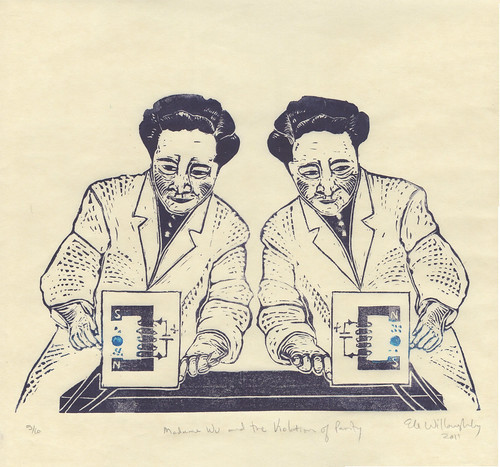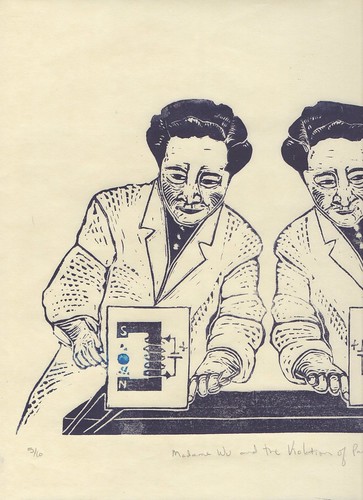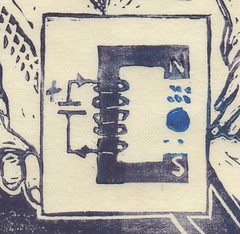
Long before we had (Einsteinian) Special Relativity, there was Galilean Relativity which tells us that the laws of physics are the same in all inertial (non-accelerating) frames of reference. This means that if you do an experiment here, in your living room, or as Galileo noted, on a smoothly travelling boat floating at constant velocity, you get the same result. Einstein had the great insight that there are limits to Galilean invariance at great velocities approaching the speed of light. He made this based on a symmetry, by the way, which can be seen in Maxwell's equations which govern electromagnetics; this is a great example of how symmetries are invaluable to understanding our world.
Parity, in physics, is the name we give a certain symmetry of anything which is invariant under spatial inversion, by which we really mean if you reflect things as in a mirror. So, anything which doesn't change if you flip sides like in a mirror conserves parity. If you drop your pencil with your right hand it drops at 9.8 m/s2 and if you drop your pencil with your left hand it drops at 9.8 m/s2. We expect things to behave the same even if we reflect everything in the mirror. We assume parity is conserved. This is the sort of bias which is hard to see. Because, parity is conserved for gravity (like the pencil dropping example), electromagnetics, and even for the strong force (which explains how atomic nuclei hold together). But it turns out that the weak force (which explains beta decay) does not conserve parity; it doesn't obey the mirror symmetry.
 In 1956, the work of theoretical physicists Tsung Dao Lee and Chen Ning Yang suggested that perhaps the weak force might not be the same 'through the looking-glass'. Further they noted that this remained untested. The bias was strong. In fact, physicists thought of the "Law" of Parity Conservation and thus Lee and Yang weren't taken seriously until Lee convinced his colleague at Columbia University, the brilliant experimentalist Chien-Shiung Wu to test the theory.
In 1956, the work of theoretical physicists Tsung Dao Lee and Chen Ning Yang suggested that perhaps the weak force might not be the same 'through the looking-glass'. Further they noted that this remained untested. The bias was strong. In fact, physicists thought of the "Law" of Parity Conservation and thus Lee and Yang weren't taken seriously until Lee convinced his colleague at Columbia University, the brilliant experimentalist Chien-Shiung Wu to test the theory.  Chien-Shiung Wu (1912-1997, Chinese-born American physicist, whose nicknames included the “First Lady of Physics”, “Chinese Marie Curie,” and “Madame Wu”) came up with a truly beautiful experiment to test whether the weak force conserves parity. In my print on the left I show Mme. Wu in her lab and a schematic diagram in the box shows the heart of one half of her experiment. Mme. Wu is reflected in the mirror on the right side, and the second half of her experiment (shown schematically) is shown in the box - what actually happens when the reaction is reflected in the mirror. She chose to use Cobalt-60, which I've designated with the cobalt blue sphere. Cobalt-60 is radioactive and beta decays naturally; neutrally charged neutrons within its atomic nuclei spontaneously give off electrons and become protons. (This shows another symmetry and conservation law: conservation of charge. A neutron is neutral, it has zero charge. An electron has charge -1 and a proton has charge +1. So the total charge before is equal to the total charge after). She placed the Cobalt-60 withing a strong magnetic field, designated by an electromagnet on the print. You see a power source (a long horizontal line with shorter horizontal line on top labelled '+') connected to a wire spiralled around a horseshoe-shaped metal piece which becomes an electromagnet. The top side becomes the North pole of the magnet and the bottom the South. The electrons given off by beta decay (the tiny dots) are preferentially given off in the direction of the North pole (upwards). Now, when you reflect this set-up in the mirror the poles of the magnet must switch, with the North pole on the bottom. The directionality of the magnetic field is determined by the 'right-hand rule'. Using your right hand, if you curl your fingers in the same direction as the spirally wire, your thumb will point toward the North pole of the magnet. If you reflect the horseshoe and wire in the mirror, you find your thumb points the opposite way. When Cobalt-60 is placed in this spatially inverted set-up, the electrons emitted go the opposite way, downward toward the North pole of the magnet. As you can see in the print, the result is not the mirror image even though the set-up is the mirror image. To actually measure this effect of course, more care and subtlety were required than shown in my schematic; it involved cooling the Cobalt-60 in a special cryogenic facility and very large magnetic fields - but it was as ingenious and elegant as the simplified version. To my mind, this is undoubtedly a beautiful experiment and the results were nothing short of stunning. For their theoretical work on the question of parity in the physics of subatomic particles, Lee and Yang were quickly awarded the Nobel Prize for Physics in 1957; the Nobel committee neglected to include Wu.*
Chien-Shiung Wu (1912-1997, Chinese-born American physicist, whose nicknames included the “First Lady of Physics”, “Chinese Marie Curie,” and “Madame Wu”) came up with a truly beautiful experiment to test whether the weak force conserves parity. In my print on the left I show Mme. Wu in her lab and a schematic diagram in the box shows the heart of one half of her experiment. Mme. Wu is reflected in the mirror on the right side, and the second half of her experiment (shown schematically) is shown in the box - what actually happens when the reaction is reflected in the mirror. She chose to use Cobalt-60, which I've designated with the cobalt blue sphere. Cobalt-60 is radioactive and beta decays naturally; neutrally charged neutrons within its atomic nuclei spontaneously give off electrons and become protons. (This shows another symmetry and conservation law: conservation of charge. A neutron is neutral, it has zero charge. An electron has charge -1 and a proton has charge +1. So the total charge before is equal to the total charge after). She placed the Cobalt-60 withing a strong magnetic field, designated by an electromagnet on the print. You see a power source (a long horizontal line with shorter horizontal line on top labelled '+') connected to a wire spiralled around a horseshoe-shaped metal piece which becomes an electromagnet. The top side becomes the North pole of the magnet and the bottom the South. The electrons given off by beta decay (the tiny dots) are preferentially given off in the direction of the North pole (upwards). Now, when you reflect this set-up in the mirror the poles of the magnet must switch, with the North pole on the bottom. The directionality of the magnetic field is determined by the 'right-hand rule'. Using your right hand, if you curl your fingers in the same direction as the spirally wire, your thumb will point toward the North pole of the magnet. If you reflect the horseshoe and wire in the mirror, you find your thumb points the opposite way. When Cobalt-60 is placed in this spatially inverted set-up, the electrons emitted go the opposite way, downward toward the North pole of the magnet. As you can see in the print, the result is not the mirror image even though the set-up is the mirror image. To actually measure this effect of course, more care and subtlety were required than shown in my schematic; it involved cooling the Cobalt-60 in a special cryogenic facility and very large magnetic fields - but it was as ingenious and elegant as the simplified version. To my mind, this is undoubtedly a beautiful experiment and the results were nothing short of stunning. For their theoretical work on the question of parity in the physics of subatomic particles, Lee and Yang were quickly awarded the Nobel Prize for Physics in 1957; the Nobel committee neglected to include Wu.* She did receive many other honours. Wu took part in the Manhattan Project (wikipedia states she is believed to be the only Chinese person to do so) and literally wrote the book on beta decay. She was the first: Chinese-American to be elected to the U.S. National Academy of Sciences; Female instructor in the Physics Department of Princeton University; Woman with an honorary doctorate from Princeton University; Female President of the American Physical Society, elected in 1975; winner of the Wolf Prize in Physics (1978); Living scientist to have an asteroid named after her. She won many awards and fellowships including: the Research Corporation Award 1958; the Achievement Award, American Association of University Women 1960; John Price Wetherill Medal, The Franklin Institute, 1962; Comstock Prize in Physics, National Academy of Sciences 1964; Chi-Tsin Achievement Award, Chi-Tsin Culture Foundation, Taiwan 1965; Scientist of the Year Award, Industrial Research Magazine 1974; Tom W. Bonner Prize, American Physical Society 1975; National Medal of Science (U.S.) 1975; the aforementioned Wolf Prize in Physics, Israel 1978; Honorary Fellow Royal Society of Edinburgh; Fellow American Academy of Arts and Sciences; Fellow American Association for the Advancement of Science; Fellow American Physical Society. And I bet you hadn't heard of her! I'm trying to redress that.
She did receive many other honours. Wu took part in the Manhattan Project (wikipedia states she is believed to be the only Chinese person to do so) and literally wrote the book on beta decay. She was the first: Chinese-American to be elected to the U.S. National Academy of Sciences; Female instructor in the Physics Department of Princeton University; Woman with an honorary doctorate from Princeton University; Female President of the American Physical Society, elected in 1975; winner of the Wolf Prize in Physics (1978); Living scientist to have an asteroid named after her. She won many awards and fellowships including: the Research Corporation Award 1958; the Achievement Award, American Association of University Women 1960; John Price Wetherill Medal, The Franklin Institute, 1962; Comstock Prize in Physics, National Academy of Sciences 1964; Chi-Tsin Achievement Award, Chi-Tsin Culture Foundation, Taiwan 1965; Scientist of the Year Award, Industrial Research Magazine 1974; Tom W. Bonner Prize, American Physical Society 1975; National Medal of Science (U.S.) 1975; the aforementioned Wolf Prize in Physics, Israel 1978; Honorary Fellow Royal Society of Edinburgh; Fellow American Academy of Arts and Sciences; Fellow American Association for the Advancement of Science; Fellow American Physical Society. And I bet you hadn't heard of her! I'm trying to redress that.I've been wanting to do a portrait of Chien-Shiung Wu for a while. Probably since I read The Ten Most Beautiful Experiments by George Johnson, a book which I enjoyed, despite its complete lack of female experimentalists - a fault I might have overlooked and forgiven if it weren't for the half-hearted mea culpa in the irksome afterword. I paraphrase, "Why these 10? Well it could have been another 10, but these are my 10. It was pointed out to me there are no women, sorry about that, but these are my 10. I could have included Marie Curie, but she was really just patient and precise rather than making a beautiful experiment. I could have included Mme. Wu, but, I didn't." The fact is that not only have women been under-represented in physics, but even when they have been as extraordinary and successful as C.S. Wu, they have not been celebrated, making the female minority in physics even more invisible.
Wu herself said,
... it is shameful that there are so few women in science... In China there are many, many women in physics. There is a misconception in America that women scientists are all dowdy spinsters. This is the fault of men. In Chinese society, a woman is valued for what she is, and men encourage her to accomplishments yet she remains eternally feminine.(As quoted in "Queen of Physics", Newsweek (20 May 1963) no. 61, 20.)
She also said,
I sincerely doubt that any open-minded person really believes in the faulty notion that women have no intellectural capacity for science and technology. Nor do I believe that social and economic factors are the actual obstacles that prevent women's participation in the scientific and technical field.(As quoted in Nobel Prize Women in Science by Sharon Bertsch McGrayne, 1993)
The main stumbling block in the way of any progress is and always has been unimpeachable tradition.
Also, since I'm conscious of the lack of portrayal and celebration of women in science, I've managed to highlight some amazing women in The Scientist Portraits. However, I note that the collection thus far has represented Europeans, or scientist of European decent, which is an unintentional bias. The history of science is predominately presented from a Western viewpoint, but it isn't really a story of Westerners and this is a bias to root out too.
*If you thought the Nobel awards were 'fair' or 'unbiased' I can recommend some books to disabuse you of this misunderstanding.









2 comments:
Awesome. I love learning more about lady scientists. I'll confess I don't quite understand the experiment, but anything past fundamental physics goes straight over my head :)
Thanks! I really think she should be more famous.
I had hoped I'd made the physics transparent... but it is a challenge to explain anything spatial in words. Plus, this is just plain weird!
Post a Comment